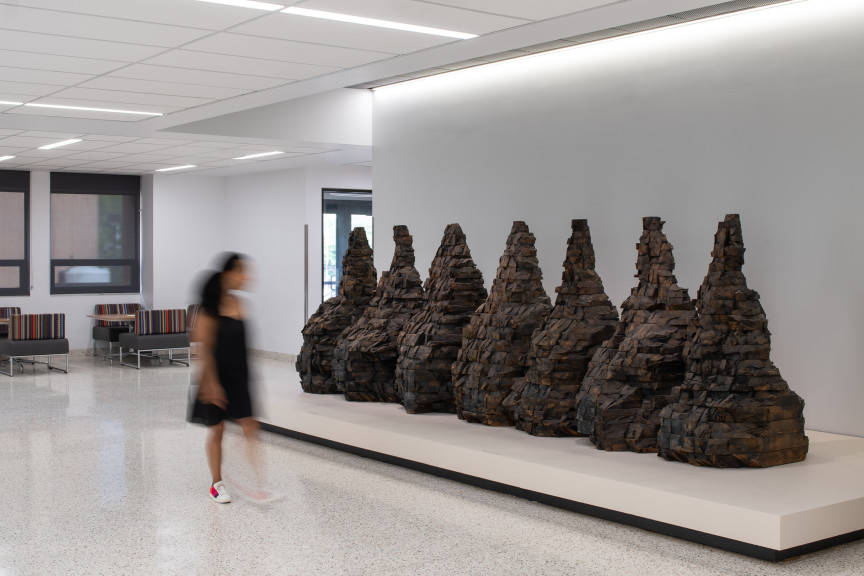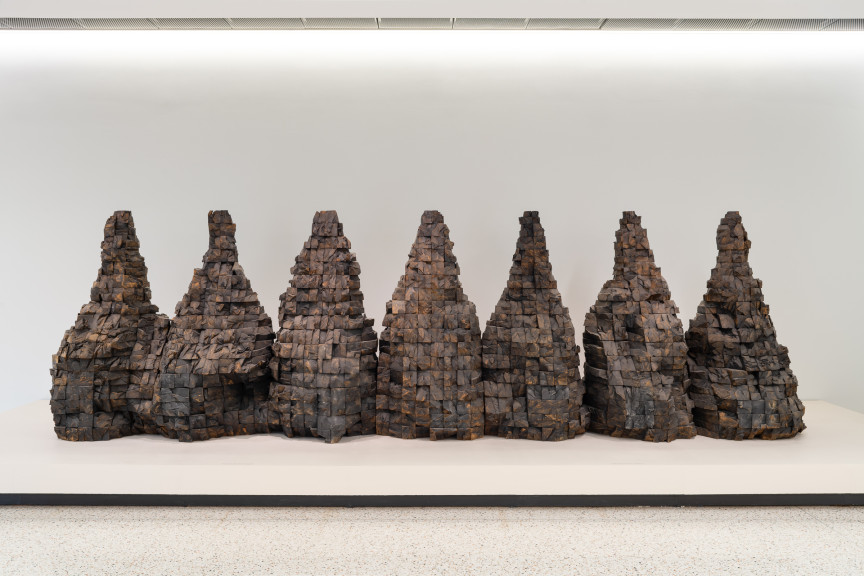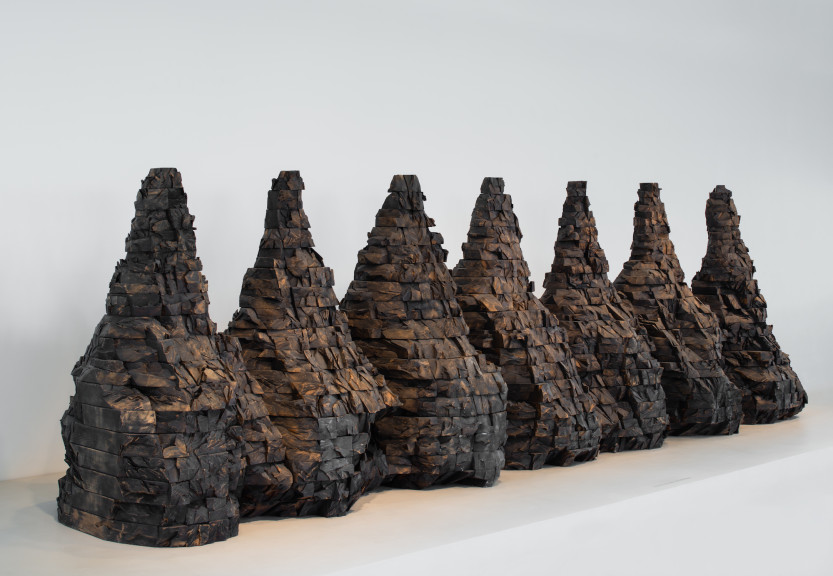Untitled (Seven Mountains)
Ursula von Rydingsvard
62 × 201 × 42 inches
Photography not permitted
Lent by The Metropolitan Museum of Art
Purchase, Lila Acheson Wallace Gift, 1988
1988.257a-u
GPS: 30.28640025, -97.73749122
The daughter of a Ukrainian peasant woodcutter who fled to Germany in 1938, Ursula von Rydingsvard spent the first eight years of her life in a succession of refugee camps until 1950 when her family settled in Plainville, Connecticut. Determined to pursue a career as an artist, she studied painting at the University of Miami and the University of California, Berkeley, and received her MFA at Columbia University in 1975.
When she arrived in New York in 1973, Minimalism was at its height. Like the Minimalists, von Rydingsvard also utilizes prefabricated materials, specifically commercially available 4×4 cedar beams. In contrast to the Minimalists, however, she works against the mass-produced quality of the material. Sculpting in an intuitive and organic way, the artist reengineers the standardized material and returns it to a more natural state. Thus, she joined the new generation of sculptors loosely labeled “Postminimalist.”
Von Rydingsvard works primarily in cedar, using chain saws, circular saws, traditional hand chisels, and a mallet to sculpt her pieces. She uses ordinary four-by-four-inch beams, a common construction material. Working against the function and precision of the beams, she carves and chips the wood into organic forms with craggy surfaces, then rubs the surfaces of some works with powdered graphite. The dark gray graphite on reddish brown cedar produces a nuanced surface coloration that suggests the patina of time.
Von Rydingsvard’s penchant for carving in wood derives from her Polish-Ukrainian roots; her ancestors were peasant farmers whose survival depended on wood for tools and shelter. In her formative years, the material surrounded her in German refugee camps. “It’s somewhere in my blood. . . . Working with it and looking at it feels familiar.”
Untitled has the subtitle (Seven Mountains), perhaps an allusion to the fact that Von Rydingsvard was one of seven children. The layers of wood resemble the stone striations of geological formations, like those visible in desert canyons or archaeological excavations. With every cut and gouge made prominent, her sculptures are representations of the highly physical, expressive act of sculpting.
ACTIVITY GUIDES
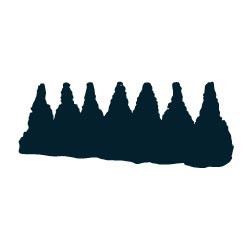
Untitled (Seven Mountains)
Ursula von Rydingsvard
Subject: Building up volume
Activity: Making a sculpture by building
Materials: Cardboard or tongue depressors, chisel and/or sandpaper, colored chalk
Vocabulary: biomorphic abstraction, graphite powder, western red cedar
Ursula von Rydingsvard lived in New York City during a time when women artists were becoming more recognized. She enjoys working in an expressive style and believes viewers should have their own personal responses to her abstract works. She builds her wood sculptures layer by layer with glue, and then shapes the wood using hand tools. The wood she uses is western red cedar. After she’s done building, she rubs the sculpture with powdered graphite. Von Rydingsvard’s artistic style is biomorphic abstraction.
What materials did the artist use? Can you identify them on the sculpture?
How do you think the sculptor carved the material? Did she use a chisel or chainsaw?
Why do you think the artist named this sculpture Seven Mountains?
Von Rydingsvard works by building up a volume of wood out of small pieces, and then she carves the surface. Build you own volume by gluing together pieces of cardboard or tongue depressors and then chip away at the surface to create a new form and texture. Finish your sculpture by rubbing colored chalk into the surface.
Biomorphic abstraction – organic forms taken from nature but not realistic
Graphite powder – a substance that is soft and gray or black, used in pencils
Western red cedar – a tree native to the Pacific coast of North America
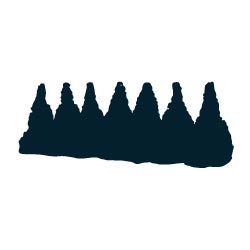
Untitled (Seven Mountains)
Ursula von Rydingsvard
Subject: Repetition of forms
Activity: Make a sculpture from small wood pieces
Materials: Small, similarly sized pieces of wood and glue
Vocabulary: expressive, graphite, organic, postminimalist
Daughter of a Ukrainian peasant woodcutter who fled to Germany in 1938, Ursula von Rydingsvard spent the first eight years of her life in refugee camps until the family came to the United States in 1950. She studied painting at the University of Miami and at the University of California, Berkeley. When she moved to New York in 1973, she turned to sculpture. Von Rydingsvard became one of the new generation of sculptors loosely labeled “postminimalist” because she used organic, natural forms to create expressive sculptures.
Von Rydingsvard constructs her sculptures from ordinary four-by-four-inch beams. She glues and dowels together layers of these beams into a massive three-dimensional grid of identically sized elements. She then chisels into the wood, leaving the surfaces craggy. Since 1986, von Rydingsvard has rubbed powdered graphite onto the surfaces of her sculptures. The dark gray graphite on reddish brown cedar produces a subtle surface coloration.
Why do you think von Rydingsvard coats her sculptures with graphite? Why not just let them stay their natural color?
What forms from nature come to mind when you look at the sculpture?
Von Rydingsvard greatly admires the pyramidal/ziggurat remains of the Maya temples in the Yucatan area of Mexico. Why do you think this is so? How do you think these structures influence her art?
Sometimes we can best understand a material’s impact by imagining a sculpture created in a different material. For instance, what if Untitled were made of reddish clay? Steel? Stone? Bronze? How would the sculpture change?
Why do you think the sculpture is subtitled Seven Mountains?
Using identically sized pieces of wood, construct your own sculpture. You might make a drawing or two on graph paper to plan out your sculpture. When you are done with the sculpture, think of ways that you might change the surface look.
Prior to 1986, von Rydingsvard rarely titled her sculptures; but since then she has preferred evocative, if sometimes baf ing, names (for example, Grzebyk, Ignatz Comes Home, Zakopane, Oj Dana Oj Dana, and Dreadfully Sorry).
Von Rydingsvard, Raoul Hague, and Hans Hokanson all used wood for their sculptures. Think about how they used wood similarly or differently. How did they cut it? How do the surfaces compare? What, if any, natural forms were they possibly inspired by?
Expressive - effectively conveying meaning or feeling
Graphite - a soft black form of carbon used for lead pencils
Organic - related to living organisms
Postminimalist - a term used for artistic work that is influenced by, or attempts to develop and go beyond, the aesthetic of minimalism (where work is stripped down to its most fundamental features)
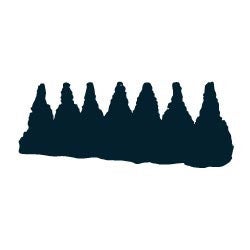
Untitled (Seven Mountains)
Ursula von Rydingsvard
Subject: Shapes found in nature
Activity: Making a sculpture from wood
Materials: Popsicle sticks, tongue depressors, wooden chopsticks, scissors, and glue
Vocabulary: Organic, geometric, sculptor, carve
Ursula von Rydingsvard is a sculptor who works in wood. Her father was a woodcutter. In her sculptures, she builds a large cube of wood by stacking and gluing wooden beams together. Using hand tools, von Rydingsvard then carves into the cube to create another shape. She uses natural materials like wood to recreate shapes and forms found in nature like mountains. Von Rydingsvard uses a simple form (square wooden beams) to create more complex forms (the triangle or pyramid) and then an even more complex arrangement (a row or range of pyramids). She enjoys working in an expressive style and believes viewers should have their own personal responses to works of art.
How are these Seven Mountains different than mountains we find in nature?
How would a manmade mountain differ from a natural one?
What else does this row of triangles look like?
What are some other shapes that are commonly found in nature?
Help your child to cut popsicle sticks, tongue depressors, and/or wooden chopsticks into different lengths. Experiment with stacking the shapes to create different forms. Encourage your child to make a square, triangle, or circle out of the different lengths of wood. Use glue to adhere them together.
Organic —Looking like shapes found in nature
Geometric —Using simple shapes and elements such as lines, circles, squares, and triangles
Sculptor —An artist who makes works of art that have height, width, and depth
Carve—To cut away from a surface
MORE INFORMATION
Untitled (Seven Mountains), 2000
Engineering is a type of problem solving that requires both technical expertise and creative thought. Imagination, ingenuity, enterprise: these qualities inform the mindset and practice of the engineer, who must be resourceful in order to solve a given problem. Engineers take into consideration data, science, and hard facts as they undertake their work. In much the same way, artists work with concrete materials—paint and canvas, wood, stone, or metal. In three-dimensional sculpture especially, the physical limitations of materials provide the conditions through which the artist conceives and executes a work of art.
The circumstances of sculptor Ursula von Rydingsvard’s early life were impacted by issues addressed by Civil, Architectural, and Environmental Engineering. One of seven children born to a peasant farming family during the Second World War, she spent her childhood years shuttled between refugee camps for displaced Poles. Wartime instability and the breakdown of infrastructure exacerbated the already precarious condition of von Rydingsvard’s family and made a lasting mark on the artist’s worldview. Art historian Patricia C. Phillips has written about the meaning of von Rydingsvard’s childhood for her subsequent artistic output, “conditions [which] required an enterprising use of whatever material or resource was available [and] connects back to a life of need-based economic resourcefulness where the privilege of waste was not an alternative.” Her body of work, in which rope, metal, and most often cedar are made into forms resembling tools and farming implements reflect the artist’s ongoing fascination with what Phillips describes as “the simple efficiencies of implements and utensils, and the frugal innovations and resourceful improvisations of common [artisans].”
When von Rydingsvard began making art in the 1970s, Minimalism was the predominant sculptural style. Artists working in this vein made art of fluorescent light tubes, sheets of copper, Plexiglas and other industrial materials, often presenting them “as is,” in geometric configurations with minimal transformation or manipulation. Like the Minimalists, von Rydingsvard also utilizes prefabricated materials, specifically commercially available cedar beams. In contrast to the Minimalists, however, she works against the mass-produced quality of the material, creatively reengineering it against its practical function. The craggy forms and rough surfaces of Untitled (Seven Mountains) result from von Rydingsvard’s repurposing the standardized material and returning it to a more natural state.
She begins by joining cedar beams together with glue and dowels. Once the large three-dimensional structure is in place, she then wields a chainsaw to chisel the wood. It was through a process of experimentation that the artist developed her particular way of using cedar beams. The inherent qualities of the material—its geometric regularity, its smooth surface—serve not as limitations but as generative conditions. Untitled (Seven Mountains) marked a pivotal moment in the artist’s practice. After executing the wooden forms, she finished the surface of the sculpture by rubbing and scouring it with graphite powder, creating a patina that calls to mind aging and erosion. This suggestion of natural forces working at a geologic pace subsequently became a primary aspect of her work. Von Rydingsvard’s studio practice entails breaking down the expectation that the beams would be used as a construction material, and reimagines its function as a vehicle for artistic expression.
—Alex Grimley
Ashton, Dore, Marek Bartelik, and Matti Megged. The Sculpture of Ursula von Rydingsvard. New York: Hudson Hills Press, 1996.
Brenson, Michael. Ursula von Rydingsvard. Kansas City, MO: Nelson-Atkins Museum of Art; and Wakefield, West Yorkshire: Yorkshire Sculpture Park, 1997. Texts by Deborah Emont Scott and Ursula von Rydingsvard.
Koplos, Janet. “Stasis and Agitation.” Art in America 89 (January 2001): 86–89, 141.
Levi Strauss, David. “Sculpture as Refuge.” Art in America 81 (February 1993): 88–93, 125.
Madison Art Center. Ursula von Rydingsvard: Sculpture. Madison, WI, 1998. Text by Martin Friedman.
Neuberger Museum of Art, Purchase College, State University of New York. Ursula von Rydingsvard: On an Epic Scale. Purchase, NY, 2002. Text by Patricia C. Phillips.
Storm King Art Center. Ursula von Rydingsvard, Sculpture. Mountainville, NY, 1992. Texts by Michael Brenson and Maureen Megerian.
Tully, Judd. “Ursula Von Rydingsvard.” Arts Magazine 54 (May 1980): 22.
Viney, Jill. “Ursula von Rydingsvard: A Rich, Redemptive Journey.” [interview] Sculpture 8 (November/December 1989): 32–35.
The Metropolitan Museum of Art in New York generously loaned twenty-eight modern and contemporary sculptures to Landmarks for display throughout the Austin campus. The collection represents a broad array of artists working in the second half of the twentieth century. The initial sculptures were installed throughout the main campus in September 2008, and a second, smaller group were unveiled at the renovated Bass Concert Hall in January 2009.
Funding for the loan was provided by the Office of the President. This project was the result of a collaborative effort among many, including:
Leadership
Andrée Bober and Landmarks
Pat Clubb and University Operations
Douglas Dempster and the College of Fine Arts
Landmarks Advisory Committee
William Powers and the Office of the President
David Rea and the Office of Campus Planning
Bill Throop and Project Management and Construction Services
Gary Tinterow and the Metropolitan Museum of Art
Samuel Wilson and the Faculty Building Advisory Committee
Project Team
Chuck Agro, transportation, Metropolitan Museum of Art
Andrée Bober, curator and director, Landmarks
Caitlin Corrigan, registrar, Metropolitan Museum of Art
Cynthia Iavarone, collections manager, Metropolitan Museum of Art
Cliff Koeninger, architect
Ricardo Puemape, Project Management and Construction Services
Kendra Roth, conservator, Metropolitan Museum of Art
Patrick Sheehy, installation services
Nicole Vlado, project manager, Landmarks
Special Thanks
Valerie Fletcher, curatorial contributor
Beth Palazzolo, administrative coordination, University Operations
Russell Pinkston, composer
What’s Past Is Prologue: Inaugurating Landmarks with the Metropolitan Sculptures
With the arrival of twenty-eight modern sculptures on long-term loan from New York’s Metropolitan Museum of Art, the Landmarks program has begun. Their installation throughout the Austin campus offers a remarkable opportunity to survey some of the major trends in art during the second half of the twentieth century. These sculptures allow us to witness the distinctly modern dialogue between representation and abstraction, as well as the contest between natural and industrial materials. Most of all, we can celebrate their presence as an unprecedented chance to experience works of art first-hand––to appreciate their forms and to understand the underlying ideas.
The Landmarks program perpetuates in Austin one of civilization’s oldest and most enduring traditions: the placing of art in public areas, accessible to nearly everyone and expressive of collectively held ideas. More than five thousand years ago, the cultures of Egypt and Mesopotamia produced sculptures for urban plazas, government buildings, and places of worship to express political, secular, and religious values. Grand monuments endorsed the ruling elite and commemorated military victories, while images of deities symbolized spiritual beliefs. The original purposes of public art were primarily ideological and didactic, but what has endured through the ages is the physical beauty of the art. In modern times the contexts and goals for public art have changed considerably. In many parts of the world democracy and egalitarianism have supplanted absolute rulers, and explicit religious power has yielded to secular humanism. During the mid-to-late twentieth century (the era when the Metropolitan’s sculptures were created), globalization has redefined the entire world. Societies in Europe and the Americas have became so diverse that cultural authorities can no longer be sure of which systems of meaning and which values, let alone which individuals, should be honored in the traditional ways of public art.
A schism has developed between traditionalists and modernists. In a rapidly changing world those who wanted to preserve the familiar in art have continued to commission representational statues. Modernists, on the other hand, have embraced change and gladly jettisoned the old ways in favor of abstraction. The schism is exemplified by two famous memorials in Washington, D.C., both intended to commemorate the heroic sacrifices of American armed forces. The Marine Corps Memorial (1954) consists of a superbly realistic representation of soldiers struggling to raise the American flag on Iwo Jima in 1945. In contrast, the Vietnam Memorial (1982) consists of a massive V-shaped wedge of polished black stone inscribed with What’s Past Is Prologue: Inaugurating Landmarks with the Metropolitan Sculptures July 2008 the names of the dead. At the time it was inaugurated, this monument shocked nearly everyone outside the art world and outraged many of those it intended to commemorate. In response, a group of bronze figures of soldiers was added. But soon, precisely because of its universal form and absence of imagery, the original memorial became a powerful place where all Americans could go to grieve, remember, and pay homage. To most of the art world, this demonstrated beyond a doubt the viability of abstract sculpture for public places.
With America’s increasing wealth and social consciousness in the 1960s many towns began to institute programs of commissioning sculptures for public places. By requiring that 1 or 2 percent of each building’s construction budget be used for art, urban planners sought to improve the living and working environment for millions of people. The main difficulty was agreeing on what kind of art was visually pleasing and, just as important, potentially meaningful to the general public. Two highly publicized examples were the huge, abstract, metal sculptures by Pablo Picasso and Alexander Calder, in Chicago and Grand Rapids respectively, which at first provoked derision but gradually became a source of community identity and pride.
One way to approach works of art is to consider the historical context in which they were created. During the first half of the twentieth century, life and art underwent radical transformations. Industrial manufacturing supplanted agriculture as the dominant mode of production, people migrated from rural areas to urban centers, women and minorities gained equal rights, warfare expanded to an unprecedented global scale, and technology accelerated the pace of life—and art changed in tandem.
Abstraction
Early in the modern era, many artists believed that a new visual language was needed to replace the Greco-Roman classical figurative traditions that had persisted through two millennia. Photography had made mimesis (accurate depiction of reality) unnecessary in painting and sculpture for the first time in history. Artists were free to conceive radically new approaches, and so abstraction was born, emerging from 1910 to 1920 in Europe. Initially artists simplified and stylized observed reality into organic and angular forms. That first phase soon evolved into making “pure” abstractions with no recognizable sources. From the outset, abstract art carried implicit meanings recognized by artists and informed viewers but largely lost on the general public.
Early abstractionists intended their art to convey their commitment to an ongoing transformation of society. Like Morse code in telegraphy and other new modes of communication fundamentally different from the traditional written word, abstract forms in art could convey meanings—not narrative or literal ones but broad ideas that could speak to an international audience and help advance human consciousness.
During the 1920s and 1930s, artists developed two broad types of abstraction: geometric and biomorphic. Geometry denotes mathematics and suggests such related disciplines as architecture, design, engineering, and logic as well as intangible qualities like analytical thinking and precision—desirable attributes for a rational, communal society. Artists devised a new language of geometry in art: horizontal and vertical elements can convey calm, harmony, and stability (see Harmonious Triad by Beverly Pepper), while rising diagonals can suggest energy and optimism (see Column of Peace by Antoine Pevsner and Square Tilt by Joel Perlman).
In contrast to geometric abstraction, a number of artists favored softer forms and curving contours. Inspired by sources in nature, biomorphic abstractions evoke natural phenomena, biological processes, growth, and ambiguity (see Big Indian Mountain by Raoul Hague, Source by Hans Hokanson, and Untitled [Seven Mountains] by Ursula von Rydingsvard). Such works stand in general opposition to the industrial and technological aspects of modern life; they remind us of the fundamental importance of the natural world. Biomorphism was invented and advocated by the surrealists, who believed in the importance of the unconscious mind in creating and understanding modern art. Relying on the Freudian concept of free association, such artists expect viewers to generate their own unique responses to abstract art.
The two types of abstraction began as competing and opposing philosophies, but by the 1950s many artists expertly combined them to suit their expressive needs (see the rhythmic contours of Veduggio Glimpse by Anthony Caro and the disconcerting, hulking forms of Catacombs and Guardian by Seymour Lipton).
By the 1960s, the original philosophical meanings underlying abstraction had mostly faded away, leaving “formalist” aesthetics: the creation and appreciation of pure nonreferential beauty. Formalism dominated much artistic practice from the 1950s through the 1970s, particularly in the United States in the circle around the critic Clement Greenberg. Geometric sculptures became ubiquitous in public places—some complex and sophisticated and some merely competent. A group known as the minimalists advocated an intellectually rigorous, austerely reductivist approach (see Amaryllis by Tony Smith). Other artists went in the opposite direction, toward complexity and a decorative verve (see Kingfish by Peter Reginato). From those extremes emerged the postminimalists, who infused organic vitality into simple, singular forms (see Curve and Shadow No. 2 by Juan Hamilton).
Figuration
Despite the enthusiasm for abstraction in midcentury, a number of artists insisted on maintaining recognizable human content in their works. Abstraction had alienated many viewers who found it remote or incomprehensible. Yet few artists returned to traditional realism, preferring instead to explore new and evocative modes of representation.
The strongest resurgence occurred in the aftermath of World War II. Many artists, especially in Europe, wanted to pay homage to the sufferings experienced by so many people during the war and to their struggles to rebuild their lives and societies amidst the new fears engendered by the nuclear age and the Cold War. This atmosphere of postwar existential anxiety was poignantly expressed in two museum exhibitions in the 1950s: models for a never-realized Monument to the Unknown Political Prisoner at London’s Tate Gallery in 1953 and the avowedly humanist theme of the New Images of Man installation at New York’s Museum of Modern Art in 1959.
Many postwar sculptors expressed their angst by portraying figures or fragments of bodies as falling, broken, injured, or partially robotic (see Augustus by Bernard Meadows and Figure by Eduardo Paolozzi). Some erudite artists reinterpreted classical myths, particularly those in which a hero challenged the gods and were punished: Icarus, Hephaestus, Prometheus, Sisyphus (see works by Koren der Harootian and Frederick Kiesler). Seymour Lipton created a particularly effective amalgam of figure references within abstract forms that harbor dark inner spaces (see Pioneer, Catacombs, and Guardian).
Representational sculpture was submerged by the tidal wave of abstraction in the 1960s and 1970s, but a new generation insisted on a legible humanist content in art, addressing issues of personal identity and isolation in an impersonal world (see Eyes by Louise Bourgeois and Figure on a Trunk by Magdalena Abakanowicz).
Materials and Methods
Modern sculptors also introduced a new language of materials and methods. In the late nineteenth century, sculpture making had entered a new phase of mass production made possible through technology: bronzes could be produced in large editions by skilled technicians from an artist’s original. The Thinker by Auguste Rodin, for example, was made in several editions, ranging from a dozen life-size bronzes to hundreds of smaller casts. This mechanization and concomitant commodification of art prompted a reaction. Appearing simultaneously in several countries, the “direct carve” movement advocated older craft-based methods and sought to enhance the intrinsic characteristics of natural materials: the color and grain of exotic woods or the veining and crystalline structure of unusual stones. By the 1920s, this aesthetic had gained international prominence, and it persists to this day.
The first generation of direct carvers admired prehistoric, African, Oceanic, and indigenous American artifacts. By adapting the hieratic frontality and stylized forms of those sources to the sleekly refined forms of abstraction, modern sculptors could represent simplified figures linked in sophisticated linear rhythms (see works by Koren der Harootian and Anita Weschler). Recent artists of this orientation tend to work on a larger scale and may roughly cut and hew wood to achieve expressionistic textures (see works by Hans Hokanson and Ursula von Rydingsvard).
Carvers remained a relatively small minority in modern sculpture, far outnumbered by “direct metal” sculptors. Their approach emerged in prewar Europe and burgeoned into an international movement in the 1950s and 1960s. Seeking materials and methods appropriate to the modern Machine Age, artists looked to engineering and construction for inspiration. Instead of using chisels to carve wood and stone, constructivists preferred welding torches to cut and join pieces of metal. Their structures ranged from elegant abstractions to assemblages of cast-off objects.
The industrial analogy and model extended to the sculptors’ own studios, which resembled factory spaces with heavy-duty equipment. Some—like Anthony Caro, Willard Boepple, and Robert Murray—found inspiration in working spontaneously and experimentally with sheet metal: cutting, folding, rolling, welding, soldering, and sometimes painting or burnishing it. Other sculptors, notably Tony Smith, were comfortable with sending models to factories for professional fabrication. Both methods were considered appropriate for a modern world that had been so fundamentally reshaped by industrial manufacture.
In contrast, many sculptors preferred to make assemblages from miscellaneous bits and pieces of scrap, sometimes irreverently called “junk sculpture.” Although artists had experimented with this approach as early as the 1910s, it became a widespread tendency only decades later in the 1950s and 1960s, when sculptors made three-dimensional collages from the detritus of industrial manufacture and mass consumption: rusty machinery, old car parts, squished used paint tubes, broken musical instruments, virtually anything. The motivations for using trash range from simple necessity (when an artist has no money to buy new materials) to antimaterialistic social criticism and environmentalism (sculptors started recycling long before the idea occurred to others).
Regardless of the motivations, a found-object sculpture possesses an inherent dual identity: its former reality as a useful thing and its new reality as art. That dualism inevitably poses an intellectual and visual conundrum for us. Do we see Deborah Butterfield’s Vermillion primarily as a lifelike depiction of a horse or as a composition of rusty, crumpled bits of metal thrown out by a wasteful consumerist society? And what are we to understand from Donald Lipski’s seemingly abstract The West, which consists of decontextualized harbor buoys and lots of corroded pennies? The artists offer clues and hope that we will use our own eyes, intellect, intuition, and imagination to make connections and create meanings.
Landmarks: Sculptures for Inquiring Minds
Unlike works in private collections or even museums, public sculptures exist in our daily environment, interact with our activities, and enter our awareness repeatedly and variously. Beyond the pleasure they bring to viewers already acquainted with art, they can stimulate curiosity and spark new perceptions in the minds of passersby who might otherwise not have much aesthetic experience. As the university’s population seeks knowledge in classes, libraries, and laboratories, the Landmark sculptures can offer other kinds of discoveries. Visitors to the Perry Castañeda-Library, the Nano Science Technology Building, the School of Law, and elsewhere on the campus can now see immediately that the visual arts have a prominent place and come away enriched. Very few campuses or cities can boast so many sculptures of such quality that are free and accessible to all. The twenty-eight sculptures from the Metropolitan Museum of Art proclaim the broad purpose of the Landmarks program: to bring an important new dimension to the life of the university, to the everyday experience of its students, faculty and staff, the citizens of Austin and beyond, and to any person who just crosses the campus.
Valerie Fletcher is Senior Curator at the Hirshhorn Museum in Washington, D.C. Her research on groundbreaking aspects of international, globalized, and transnational art have resulted in numerous exhibitions and publications.

